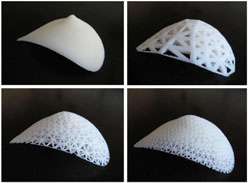Research advances breast reconstruction

Breast reconstruction surgery will become both safer and more realistic thanks to research led by Queensland University of Technology (QUT) in Brisbane, Australia.
Professor Dietmar W. Hutmacher from QUT's Institute of Health and Biomedical Innovation (IHBI) recently conducted a research project in collaboration with engineers and surgeons in Singapore and Germany, which used computer aided design (CAD) to produce moulds accurately modelled on a laser scan of a patient's healthy breast.
Surgeons successfully used the moulds during three tissue reconstruction operations.
"Previously the surgeon would do everything by eye and feel. With the mould they have a physical template to check out the exact shape and tissue volume needed for the reconstruction surgery," Professor Hutmacher said.
The three patients taking part in the study reported higher levels of satisfaction with the surgery results than those in a control group.
While these moulds have proven to be useful in surgery where tissue is taken from a patient's own body, for example, their abdomen, Professor Hutmacher is now developing the technology so that it can allow for breast tissue engineering.
The CAD which created the moulds has also been used to create biodegradable 3D scaffolds, on which a patient's own tissue could be grown.
"When you think about the volume of a breast, to recreate this with randomly shaped tissue removed from elsewhere on a patient's body is quite difficult. Normally patients have two or three operations to enable the surgeon to correct and get the shape right," Professor Hutmacher said.
"With scaffolding you can get the shape and form right from the beginning, using a small amount of tissue - around one cubic centimetre - from the patient.
"The scaffold is biodegradable. After two to three years it will dissolve, whereas silicone implants, the most common material used in breast reconstruction surgery, stays forever and can cause a lot of long-term problems such as fibrous encapsulation."
Professor Hutmacher said that he is currently testing different materials for the scaffolding. The goal is to have this technology ready for clinical use in three to five years.
















